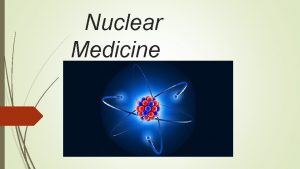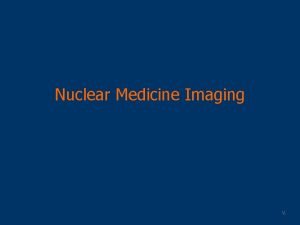Nuclear Medicine www assignmentpoint com Nuclear Medicine Tracers




















- Slides: 20

Nuclear Medicine www. assignmentpoint. com

Nuclear Medicine Tracers It is important to be able to study internal organs, or tissues, without the need for surgery. In such cases, radioactive tracers can be injected into the body so such studies can take place. The path of these tracers can be detected using a gamma camera because of their radioactivity. Such tracers consist of two parts: • A drug which is chosen for the particular organ that is being studied. • A radioactive substance which is a gamma emitter. www. assignmentpoint. com

Tracers Used in Nuclear Medicine Pharmaceutical Source Activity (MBq) Medical Use Pertechnetate 99 m. Tc 550 - 1200 Brain Imaging Pyrophosphate 99 m. Tc 400 - 600 Acute Cardiac Infarct Imaging Diethylene Triamine Pentaacetic Acid (DTPA) 99 m. Tc 20 - 40 Lung Ventilation Imaging Benzoylmercaptoacetyltri glycerine (MAG 3) 99 m. Tc 50 - 400 Renogram Imaging Methylene Diphosphonate (MDP) 99 m. Tc 350 - 750 Bone Scans www. assignmentpoint. com

Factors Which Affect the Choice of Tracer Such tracers are chosen so that: • They will concentrate in the organ, or tissue, which is to be examined. • They will lose their radioactivity (short t). • They emit gamma rays which will be detected outside the body. www. assignmentpoint. com

Factors Which Affect the Choice of Tracer • Gamma rays are chosen since alpha and beta particles would be absorbed by tissues and not be detected outside the body. • Technitium-99 m is most widely used because it has a half-life of 6 hours. www. assignmentpoint. com

Why is a half-life of 6 hours important? A half-life of 6 hours is important because: • A shorter half-life would not allow sufficient measurements or images to be obtained. • A longer half-life would increase the amount of radiation the body organs or tissues receive. www. assignmentpoint. com

The Gamma Camera The tracer is injected into the patient. The radiation emitted from the patient is detected using a gamma camera. A typical gamma camera is 40 cm in diameter – large enough to examine body tissues or specific organs. The gamma rays are given off in all directions but only the ones which travel towards the gamma camera will be detected. www. assignmentpoint. com

The Gamma Camera A gamma camera consists of three main parts: • A collimator. • A detector. • Electronic systems. electronic systems detector collimator www. assignmentpoint. com

The Gamma Camera The Collimator • The collimator is usually made of lead and it contains thousands of tiny holes. • Only gamma rays which travel through the holes in the collimator will be detected. www. assignmentpoint. com

The Gamma Camera The Detector • The detector is a scintillation crystal and is usually made of Sodium Iodide with traces of Thallium added. • The detector is a scintillation crystal and it converts the gamma rays that reach it into light energy. www. assignmentpoint. com

The Gamma Camera The Electronic Systems • The electronic systems detect the light energy received from the detector and converts it into electrical signals. www. assignmentpoint. com

Diagnosis Static Imaging • There is a time delay between injecting the tracer and the build-up of radiation in the organ. • Static studies are performed on the brain, bone or lungs scans. www. assignmentpoint. com

Diagnosis Dynamic Imaging • The amount of radioactive build-up is measured over time. • Dynamic studies are performed on the kidneys and heart. www. assignmentpoint. com

Dynamic Imaging The Renograms are dynamic images of the kidneys and they are performed for the following reasons: • • • To assess individual kidney and/or bladder function. To detect urinary tract infections. To detect and assess obstructed kidney(s). To detect and assess vesico-ureteric reflux. To assess kidney transplant(s). www. assignmentpoint. com

Performing the Renogram • The tracer is injected into the patient. • The radioactive material is removed from the bloodstream by the kidneys. • Within a few minutes of the injection, the radiation is concentrated in the kidneys. • After 10 – 15 minutes, almost all of the radiation should be in the bladder. • The gamma camera takes readings every few seconds for 20 minutes. www. assignmentpoint. com

www. assignmentpoint. com

Diagnosis The Renogram • The computer adds up the radioactivity in each kidney and the bladder. • This can be shown as a graph of activity versus time – a timeactivity curve. www. assignmentpoint. com

A Normal Renogram www. assignmentpoint. com

An Abnormal Renogram www. assignmentpoint. com

Sterilisation • Radiation not only kills cells, it can also kill germs or bacteria. • Nowadays, medical instruments (e. g. syringes) are prepacked and then irradiation using an intense gamma ray source. • This kills any germs or bacteria but does not damage the syringe, nor make it radioactive. www. assignmentpoint. com
 Bài thơ mẹ đi làm từ sáng sớm
Bài thơ mẹ đi làm từ sáng sớm Cơm
Cơm Chapter 24: nuclear chemistry answer key
Chapter 24: nuclear chemistry answer key Radioactive tracers in agriculture
Radioactive tracers in agriculture Lesson 15 nuclear quest nuclear reactions
Lesson 15 nuclear quest nuclear reactions Fisión nuclear vs fision nuclear
Fisión nuclear vs fision nuclear Addition polymerization
Addition polymerization Assignmentpoint.com bangladesh
Assignmentpoint.com bangladesh Assignmentpoint
Assignmentpoint Assignmentpoint.com
Assignmentpoint.com Www.assignmentpoint.com
Www.assignmentpoint.com Mail @ assignmentpoint.com
Mail @ assignmentpoint.com Income elasticity of demand formula
Income elasticity of demand formula Www.assignment
Www.assignment Www.assignmentpoint.com
Www.assignmentpoint.com Assignmentpoint.com
Assignmentpoint.com Conclusion of deforestation
Conclusion of deforestation Assignment point.com
Assignment point.com Objectives of computer hardware
Objectives of computer hardware Glibbering
Glibbering Assignment point
Assignment point






































